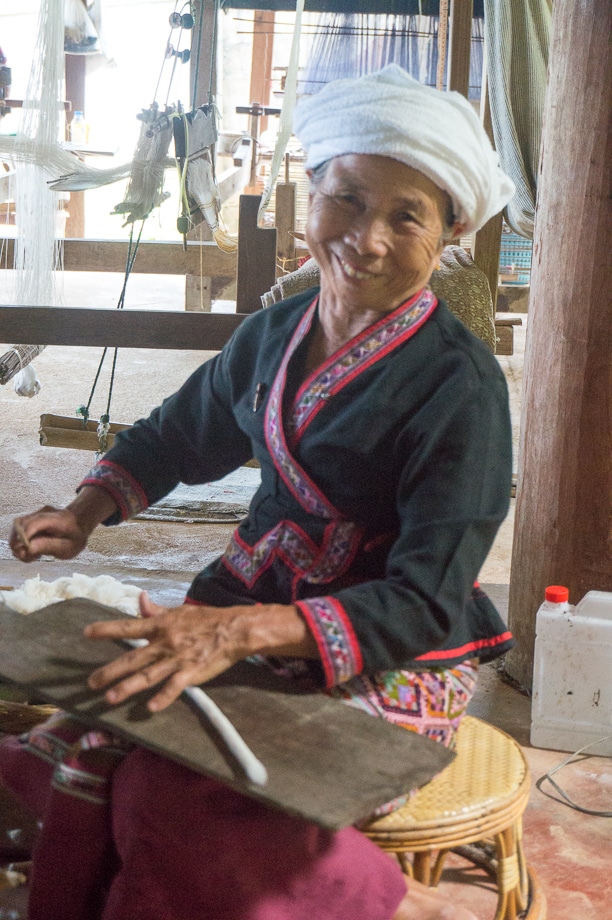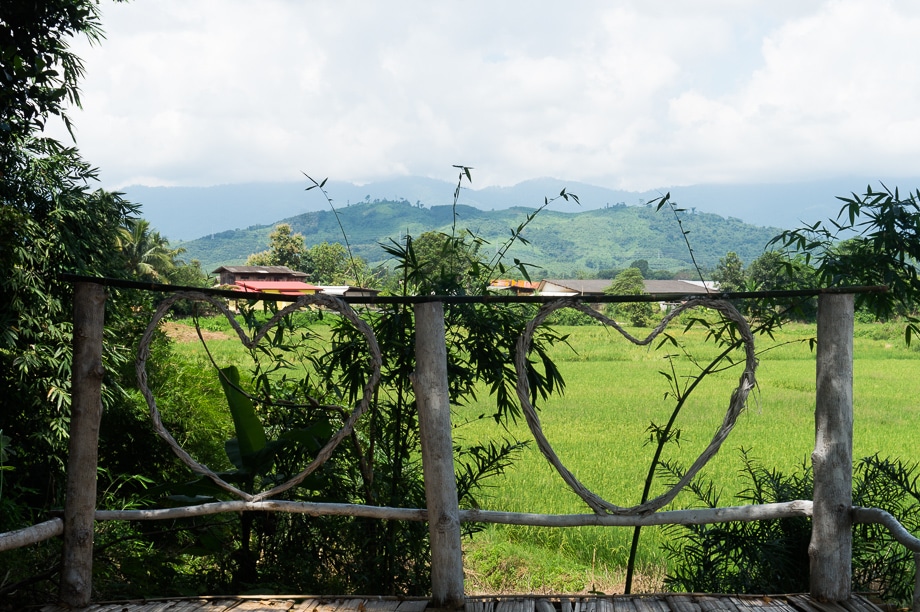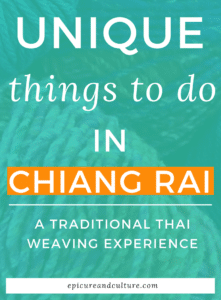By Katie Dundas, Epicure & Culture contributor
Sure, weaving in Thailand may not come to mind before Full Moon parties and white sand beaches when you think of this South East Asian country; but when you visit Chiang Rai you’ll be privy to this unique cultural experience.
And more.
Set in Thailand’s far north, near the borders of Laos and Myanmar — known as the Golden Triangle — Chiang Rai is often overlooked for the more well-known Chiang Mai.
But it shouldn’t be.
Because Northern Thailand tourism offers its own unforgettable attractions.
Psst – Don’t forget to pin this post for later!
Chiang Rai Attractions
A small sampling of the many things to do in Chiang Rai include:
- visiting the modern and provocative Wat Rong Khun (“the White Temple”),
- spending time at the mysterious artist’s residence known as the Baan Dam (“the Black House”),
- and savoring mouthwatering northern Thai cuisine (don’t miss the Kao Soi!)
The province of Chiang Rai is also home to one of the most unique and beautiful traditions within the country:
Tai Lue weaving.
The Thai government supports traditional arts — such as weaving — through the OTOP program.
OTOP, or “One Tambon (a Thai geographical sub-district) One Product,” is a stimulus program.
Essentially, it allows each village in Thailand to continue producing their local Thai products.
Historically, these Thai handicrafts have had significance in Thailand’s traditions and customs.
The chosen product is then branded as a “starred OTOP product”. From there, OTOP gives the creators a platform to sell their goods on a wider scale.
And the best part for Thailand travelers wanting global good experiences?
This program allows them to have more meaningful and authentic cultural experiences when visiting.
Other OTOP products include pottery, silks (more traditional Thai fabric design), wooden handicrafts, and local Northern Thai foods like Khao Soi, glutinous rice, and Nam Phrik.

As a result, visitors to Chiang Rai can learn about a range of traditional arts — like Saa paper making, bamboo weaving or Tai Lue weaving— and know their experience is directly benefiting the local community.
The Art Of Tai Lue Weaving In Thailand
Tai Lue weaving is a specialty of the Tai Lue people of the Chiang Rai province.
The weaving is a complex process and involves spinning locally grown cotton into thread. It is then dyed into vibrant colors like indigos, reds, and greens.
From there, the bright cotton thread is woven on a loom into intricate patterns with cultural significance, like elephants and flowers.
The cotton yarn is used to create a range of products:
Clothing for men and women, robes, blankets, and bags.
The intricate weavings are made by the namesake Thai ethnic group, the Tai Lue.
Historically, they were located within Thailand’s Golden Triangle. The Tai Lue can be found in Laos, Northern Thailand, southwest China, and parts of Myanmar and Vietnam; however, in China, the Tai Lue are known as part of the Dai ethnic group.
Weaving is a vital part of the Tai Lue culture, and the weaving skills are passed on to each generation. Weavers have also historically held the prestigious role of weaving special clothing items for the King and the royal family.
The Tai Lue designs are intricate, delicate, and unbelievably stunning.
Colors seem to pop out of the designs, creating an artistic masterpiece that is both functional and fashionable.

Learn Thai Weaving Techniques For Yourself
If you are visiting Chiang Rai, a visit to the Ban Hat Bae Tai Lue Weaving Village — near the town of Chiang Khong — is the best way to learn more about Tai Lue weaving.
This small weaving village and museum is set near the Laos border and is about an hour from the city of Chiang Rai.
It is best visited with an interpreter or as part of a guided tour.
This small community still creates Tai Lue handicrafts from start to finish, from the spinning of the cotton through to the loom weaving.
There is also a small museum in Chiang Rai that features pieces of Tai Lue fabric and clothing of cultural and historical significance in Thai culture. It offers a great introduction to the craft.

Of the many things to do in Northern Thailand, visiting the Chiang Rai village is at the top of many lists.
You can literally sit alongside local craftsmen and women as they work on different aspects of the weaving, and even try it out for yourself.
Sitting on a mat with a Tai Lue weaver, trying my hand at separating the cotton, I truly appreciated how incredibly hard it is to do this. The talent of the local weavers is truly unsurpassed.
In part thanks to the OTOP program, villages such as these are able to continue to thrive and to open their doors to the international community — not with the aim of selling products to tourists (although they can be purchased), but to foster cross-cultural communication and traditions, and to preserve the ancient Thai arts.
Ban Hat Bae Tai Lue doesn’t have a website, but you can contact Tourism Thailand for more information. Additionally, inquire at your guesthouse or local tourism agency to plan a day trip to the village.

The Importance Of Tai Lue Weaving
The Thai government recognizes that the country’s arts — such as Tai Lue weaving — are vital and must be protected for future generations:
“Thai Traditional arts and crafts have been passed through generations within communities. The importance of this rich heritage is the wealth of ancient history, knowledge, and skills that is transmitted from our ancestors and passed on to our descendants which would be irreversible.
What we can do is to preserve our traditions by spreading out this treasure to people who would love to learn and experience local arts and crafts with real locals so that our traditions will still exist,” said Ms. Suladda Sarutilavan, Director of Tourism Authority of Thailand, Sydney Office.
A visit to Chiang Rai wouldn’t be complete without spending some time learning about the region’s history and culture, and my Tai Lue weaving experience is one I won’t soon forget.
Have you tried weaving in Thailand or another cultural experience during a visit to Chiang Rai? Please share in the comments below!
Enjoyed this post? Pin it for later!





